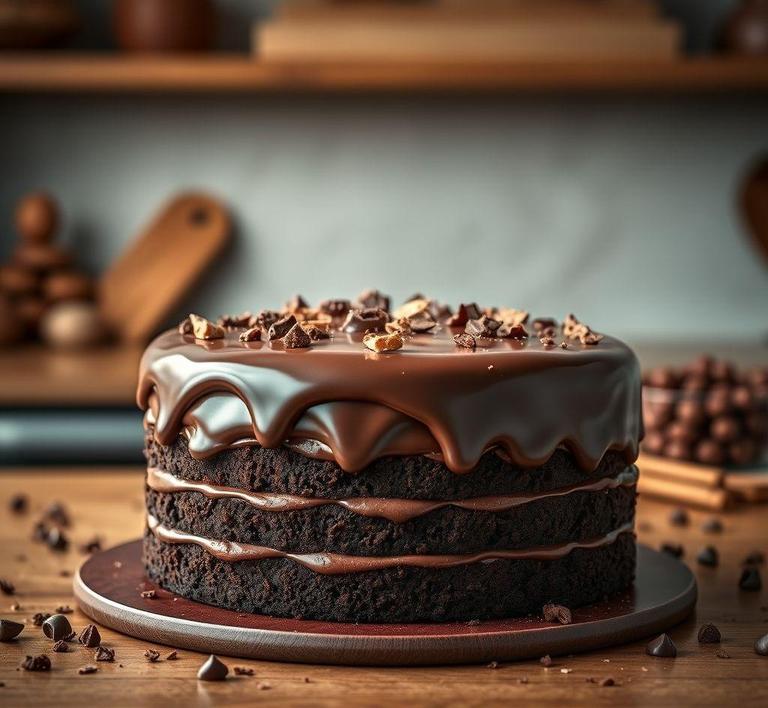If you’ve ever made a rich and indulgent chocolate gateau, you know how delicious it can be, but sometimes, you just can’t finish it all in one sitting. Whether you’ve got leftovers from a special occasion or you want to prepare it ahead of time, learning how to properly refreeze chocolate gateau can save you from waste and ensure you still get that melt-in-your-mouth experience later. Refreezing chocolate gateau might seem tricky, but with the right steps, you can keep it tasting fresh and delightful, just like the day it was made. In this guide, we’ll walk you through the best methods to freeze, thaw, and refreeze your gateau to preserve its flavor and texture.
Can You Refreeze Chocolate Gateau?

Refreezing chocolate gateau-an indulgent, rich, and decadent dessert-presents a tempting yet delicate issue. The short answer is yes, you can technically refreeze chocolate gateau, but the process requires some important considerations to preserve its quality and safety.
Chocolate gateau, with its moist layers of cake and velvety chocolate filling, is often best when fresh. Its creamy texture and flavor profile can change when subjected to freezing and refreezing. The key challenge is ensuring that the cake’s quality is maintained after thawing, refreezing, and repeated exposure to temperature fluctuations.
How To Refreeze Chocolate Gateau?
Refreezing chocolate gateau may sound simple, but there are a few crucial steps to follow to ensure the best results. Here’s a step-by-step guide to properly freezing and refreezing this beloved dessert:
1. Ensure Proper Initial Freezing
Before we get into the refreezing process, it’s important to highlight that freezing the chocolate gateau initially plays a major role in how well it will hold up later. The best way to freeze the gateau is by allowing it to cool completely at room temperature. This will help prevent the formation of ice crystals inside the cake, which can negatively affect its texture.
Once the cake has cooled, wrap it tightly in plastic wrap to avoid freezer burn. For extra protection, place it in an airtight container or seal it in a heavy-duty freezer bag. Make sure there is as little air as possible in the wrapping to minimize moisture loss and to protect the texture of the cake. It’s also a good idea to label the cake with the date it was frozen.
2. Thawing Before Refreezing
When you’re ready to thaw your chocolate gateau, remove it from the freezer and place it in the fridge for a slow, controlled thawing process. This avoids condensation from forming on the cake’s surface, which could result in sogginess. Ideally, allow it to thaw overnight.
If you’re in a rush, you can thaw it at room temperature, but avoid using a microwave or oven, as these can alter the cake’s delicate texture. Let it thaw for about 2-3 hours if you choose this method.
Once thawed, it’s time to consider if you want to refreeze it. You should only refreeze the cake if it hasn’t been exposed to warmth for extended periods or if it hasn’t already been sitting out too long. If the cake has been left at room temperature for more than a couple of hours, it’s best not to refreeze it.
3. Refreezing Process
The refreezing process is similar to the initial freezing. To maintain its quality, wrap the chocolate gateau again in plastic wrap, ensuring that all air is squeezed out. Place it back into an airtight container or a well-sealed freezer bag. If you have individual slices, it’s even easier to store the portions separately, which makes it easier to defrost smaller quantities in the future.
Keep in mind that each refreeze and thaw cycle introduces more risk of moisture loss, texture changes, or flavor degradation, so limit how many times the cake is refrozen. If you’ve already defrosted the gateau once, it’s best to refreeze it only once more, rather than repeatedly cycling it in and out of the freezer.
4. Avoiding Refreezing Frosting Or Fillings
If your chocolate gateau has delicate fillings or frosted layers, such as a whipped cream layer or ganache topping, these might not handle refreezing well. Freezing and refreezing could cause the frosting to separate, become watery, or change texture. If possible, remove any toppings before refreezing the cake. You can freeze these toppings separately and add them later for the best result.
Quality Impact
The decision to refreeze chocolate gateau does come with some quality consequences. Freezing and refreezing desserts like gateau affect the texture, flavor, and appearance in subtle ways. Let’s look at some of the key impacts:
1. Texture Changes
The primary issue with refreezing chocolate gateau is that the texture of the cake can deteriorate. Freezing causes the formation of ice crystals, and these ice crystals can disrupt the structure of the cake’s crumb. When thawed, the cake may appear more crumbly, dry, or soggy in some parts, especially if the cake has a high moisture content. Chocolate gateau’s typically rich and moist interior might lose some of its original decadence after being frozen multiple times.
2. Flavor Alteration
Freezing and refreezing can lead to a subtle but noticeable flavor change. Chocolate and other cake components-like frosting or ganache-may lose some of their fresh flavor, with the chocolate possibly becoming more muted. While freezing itself doesn’t typically spoil the cake, the delicate balance of flavors may be compromised after the gateau has gone through multiple cycles of freezing and thawing.
3. Appearance Issues
As the chocolate gateau goes through the refreezing process, it might undergo changes in appearance. Freezer burn can affect the cake’s outer layer, leaving it with unsightly discolored patches or a dry surface. Furthermore, refreezing can cause condensation to form on the cake, especially when it’s taken out of the freezer, which could result in unsightly beads of moisture on the surface. If toppings like whipped cream or ganache are involved, they may separate or melt unevenly when the gateau is refrozen.
4. Potential For Sogginess
If the gateau was originally frosted or filled with moist fillings, freezing and refreezing may result in a soggy texture once thawed. The moisture from the filling or frosting can seep into the cake, leading to a mushier or less cohesive texture, which isn’t desirable in such a delicate dessert.
5. Risk Of Bacterial Growth
Another important consideration when refreezing chocolate gateau is the risk of bacterial growth. If the cake has been left at room temperature for an extended period or if the freezing process has not been done correctly, harmful bacteria may have time to multiply. This could pose a food safety risk. Always make sure to freeze and thaw the cake at safe temperatures, and avoid refreezing it if it has been thawed improperly.
Refreezing chocolate gateau is certainly possible, but it’s not without its risks. While you can keep the dessert in the freezer for future enjoyment, repeated freezing and thawing can lead to noticeable texture, flavor, and appearance changes. The cake may become drier, more crumbly, or soggier, and the flavors may not be as vibrant as they were initially. To maintain the best quality, it’s advised to limit the number of times you freeze and thaw your gateau and to follow the correct storage methods.
To minimize the impact of freezing on the gateau, consider freezing it in slices or removing delicate toppings before refreezing. If you are serious about preserving the integrity of the dessert, it’s better to freeze it once and enjoy it in small portions, thawing only the amount you plan to eat. With careful attention, you can extend the life of your chocolate gateau while still preserving its delicious qualities, but remember that the fresher the cake, the better the experience will be.
Is It Safe To Refreeze Chocolate Gateau?
Refreezing chocolate gateau, or any other dessert, is a topic that often raises questions around food safety and quality. Chocolate gateau, being a rich and indulgent dessert made from ingredients like butter, chocolate, eggs, and cream, has a delicate balance of textures and flavors that can be easily compromised if not handled correctly when frozen and thawed. So, is it safe to refreeze it?
The short answer is: it depends. While technically, chocolate gateau can be refrozen, it is not always advisable due to several factors that could affect the quality and safety of the dessert.
Safety Considerations
The primary concern when refreezing any food is the potential growth of bacteria or pathogens that could cause foodborne illness. Refreezing works by freezing the water content in foods, which halts bacterial growth. However, each time the cake is thawed, the moisture in it becomes a breeding ground for bacteria, and refreezing it again only increases the chances of contamination if not handled carefully.
For chocolate gateau, if the dessert has been left at room temperature for an extended period, it’s recommended that you avoid refreezing it. The cake should ideally have been thawed in the refrigerator, maintaining its cold temperature until it’s ready to be eaten. If it was thawed outside the safe temperature range (above 40°F or 4°C), refreezing should be avoided.
Quality Considerations
Even if the cake is safe to eat after refreezing, the quality might not be as good. Freezing and thawing cause the moisture in the cake to crystallize, which may alter its texture, causing the cake to become dry, crumbly, or soggy. The rich, creamy texture of the ganache or frosting could break down, resulting in separation, changes in consistency, and a loss of flavor.
The delicate balance of a chocolate gateau’s components can suffer when frozen and thawed multiple times. The cake might lose its lush, dense moisture and its velvety texture, instead becoming a more brittle, dry version of itself. If you care about the texture and the melt-in-your-mouth experience of this dessert, it’s best to limit how many times it’s frozen and thawed.
Signs That Chocolate Gateau Should Not Be Refrozen
There are certain visual, textural, and sensory indicators that your chocolate gateau has passed the point of being safely refrozen. These include:
1. Visible Ice Crystals
When you thaw your gateau, the presence of ice crystals on the surface or inside the cake is a clear sign that the moisture has been compromised. These ice crystals can lead to a soggy or watery cake when refrozen and thawed again.
2. Separation Of Frosting Or Ganache
The frosting or ganache on a chocolate gateau can be highly sensitive to temperature changes. If you notice the ganache or frosting has separated into a greasy or oily layer, it’s a sign that the cake has gone through multiple temperature fluctuations, and refreezing would only make the texture worse.
3. Off Smells Or Odd Tastes
If the cake emits any sour or unusual odors, it has likely begun to spoil. This could indicate bacterial growth or the breakdown of ingredients, especially dairy, after thawing. In such cases, it is unsafe to refreeze and should be discarded.
4. Soggy, Wet Texture
A mushy, overly wet texture upon thawing indicates that the chocolate gateau has lost too much moisture during the first thaw. The risk of the cake becoming unappetizingly soggy increases with further freezing and thawing, so avoid attempting to refreeze it.
5. Time Passed Since Thawing
If your gateau has been at room temperature for more than two hours, it’s best to discard it, as bacteria will have likely begun to grow at this point. Never refreeze any cake that has been left out too long.
Common Refreezing Mistakes
Despite the best intentions, there are common mistakes people often make when attempting to refreeze chocolate gateau, leading to suboptimal results or even food safety hazards. Here’s a rundown of what to avoid:
1. Not Storing Properly Before Refreezing
One of the most critical steps when refreezing cake is to ensure it is stored correctly. If chocolate gateau is not wrapped tightly in plastic wrap or aluminum foil, or if it’s not placed in an airtight container, air and moisture can seep in, leading to freezer burn or texture changes. Freezer burn occurs when the surface of the food is exposed to air, causing dehydration and degradation of flavor.
2. Refreezing More Than Once
Each time a food item is frozen and thawed, it loses some of its original texture and flavor. Refreezing chocolate gateau multiple times will amplify this degradation, making the cake drier and less enjoyable. It’s best to only freeze your chocolate gateau once.
3. Thawing Improperly
Thawing chocolate gateau at room temperature instead of in the fridge can accelerate bacterial growth and result in a less-than-ideal texture once the cake is refrozen. Ideally, thaw the cake in the refrigerator overnight to slow down the thawing process.
4. Thawing And Refreezing In Inconsistent Conditions
When you repeatedly thaw and refreeze cake in varying temperature conditions, the delicate structure of the cake can break down, and you may end up with a mushy or crumbly dessert. Always ensure that the cake is thawed and refrozen in controlled conditions.
Tips And Tricks
Refreezing chocolate gateau doesn’t have to end in disaster if you take a few extra precautions. Here are some helpful tips:
1. Portion The Cake Before Freezing
Rather than freezing the entire gateau, cut it into smaller portions. This allows you to only thaw what you need, reducing the number of times you handle the cake and minimizing the risk of losing texture and quality.
2. Wrap The Cake Properly
Before freezing, wrap the cake tightly in plastic wrap to prevent freezer burn. Then, place it in an airtight container or a resealable plastic bag to provide an extra layer of protection against moisture loss and freezer odors.
3. Use A Freezer-Friendly Frosting
If you plan to refreeze the gateau, consider using a frosting or ganache that freezes well. Some frostings, especially those made with butter, may fare better than others, such as cream-based frostings, which tend to separate or become runny when frozen and thawed.
4. Let The Cake Cool Completely Before Freezing
Make sure the cake has fully cooled before wrapping and freezing it. This ensures that you don’t trap moisture inside the cake, which could lead to sogginess.
5. Freeze The Cake In Layers
If your chocolate gateau has multiple layers, you might want to freeze each layer separately, especially if one layer is more delicate (like mousse or cream). This helps to preserve the overall structure and prevent the layers from becoming mushy.
6. Thaw Slowly In The Refrigerator
When you’re ready to enjoy your chocolate gateau again, always thaw it slowly in the refrigerator for several hours or overnight. Thawing too quickly at room temperature can cause the cake to become soggy or collapse.
Conclusion
Refreezing chocolate gateau is a delicate process that requires attention to both food safety and quality. While it is technically possible to refreeze this decadent dessert, the results may not always be ideal, especially in terms of texture and taste. If you plan to refreeze chocolate gateau, be mindful of how it is thawed, wrapped, and stored to ensure that you preserve as much of its original richness as possible.
Keep an eye out for signs that the cake is no longer suitable for refreezing, such as separation of frosting, ice crystals, or strange odors. And always remember that with each freezing and thawing cycle, the cake will likely lose some of its charm. If you’re looking to enjoy the perfect texture and flavor, it’s best to avoid refreezing your chocolate gateau altogether and consume it soon after thawing.


